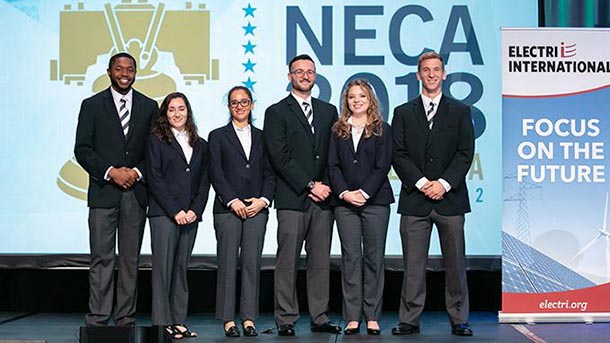
An interdisciplinary team of six Penn State engineering students recently received second place in the annual ELECTRI International Green Energy Challenge competition.
Interdisciplinary Penn State team places second in ELECTRI International Green Energy Challenge
11/5/2018
UNIVERSITY PARK, Pa. — An interdisciplinary team of six Penn State engineering students recently received second place in the annual ELECTRI International Green Energy Challenge competition. To meet the competition’s challenge, the team worked to design a net-zero energy solution for a building in a local community that houses a non-profit organization for the past year.
The competition, sponsored annually by the National Electrical Contractors Association (NECA), aims to promote partnerships between students, the community and NECA member companies. The event invites NECA student chapters to develop technical and financial proposals for improving the energy performance of a real building of their choice.
For its project, the Penn State team selected the Samuel D. Cozen Center located in Philadelphia as the focus of their proposal. Operated by the Police Athletic League (PAL), the Cozen Center offers after-school and summer programs for children. Before developing a proposal, the team traveled to Philadelphia multiple times to perform an energy audit of the building, to learn more about how the facility functioned and to see how the staff operated within the building.
“When we visited the Cozen Center it was clear that the building was in need of energy upgrades,” Taylor Schoch, third-year, architectural engineering student, said. “Our proposal focused on improving energy efficiency by adding insulation, replacing old light fixtures and upgrading the mechanical system.”
After proposing ways to lower the energy needed by the building, the team turned its attention towards how it could power the building with 100 percent renewable energy. This included the design of a solar photovoltaic system for the building’s roof and an innovative approach to use space on a neighboring building for additional solar collection. The team also designed an energy storage system that would enable the Cozen Center to serve as an emergency shelter in the event of a power outage.
“I think the energy storage system was the most interesting part of the proposal because it could serve as a back-up power source during emergencies, but also generate revenue in the grid service market,” Corey Crews-Williams, a senior majoring in energy engineering, said. “That really helped the project pencil out financially.”
Team members were also asked to develop a financial strategy.
“As a non-profit, the Police Athletic does not qualify for the tax credits that would normally apply to the solar and energy storage system,” Nisha Labroo, junior in energy engineering, said. “We had to develop a financing plan for the project that had a reasonable return on investment for a lender.”
Three years ago, Somayeh Asadi, assistant professor of architectural engineering, created a new course to help students learn to assess existing buildings and design recommendations for energy efficiency improvements. The course, AE 477 Building Retuning, teaches students measurement and observation skills using facilities on the campus, including Beaver Stadium, as living, learning laboratories.
“It’s a fun class to teach because it has a real hands-on component and also helps students learn the specialty skills to develop energy retrofit proposals like the ones required in the Green Energy Challenge,“ Asadi, who also serves as the co-advisor for the Penn State NECA student chapter, said.
Team captain Liam Cummings, a junior majoring in energy engineering, was recognized as the best presenter in the competition, and also acknowledged all those who assisted the team.
“We had a lot of help from industry partners. I liked that we were encouraged to seek input from NECA contractors and energy professionals on our proposal as opposed to doing it all ourselves,” he said. “We learned the importance of collaboration and engaging experts on the development of a complex proposal.”
Created in 2009, through a partnership between NECA and the Penn State Department of Architectural Engineering, the ELECTRI International Green Energy Challenge was specifically designed to help increase student interest in the energy efficiency and renewable energy business sectors, as well as the role electrical contractors can play in the deployment of renewable energy. The unique format of the competition includes the selection of a building in the team’s community and the need to respond to specific conditions of the building and the organization itself. Written proposals developed by student chapters are evaluated by a board of members from the electrical and energy industry. The top three teams are then invited to make an oral presentation at the annual NECA convention.
The Penn State team will present its project at the 2019 NECA convention in Las Vegas.



